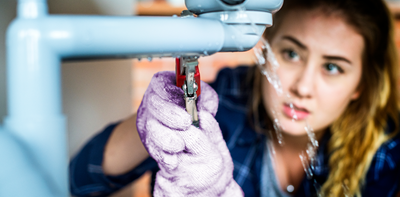From Guest Blogger Lillian Connors: Water-Efficient Plumbing–Every Drop Counts

Water pipes
The materials and technologies behind your water supply pipes have changed and evolved over the years, so in order to minimize waste and leaks, you want to make sure they are the right type and size for your house needs. Copper pipes are a popular choice indoors, due to their durability and ability to hold heat well. However, lately more and more homeowners are opting for the new generation of PEX pipes, which are cheaper to install and provide excellent thermal conductivity, as well.
Low-flow fixtures
Perhaps yesterday still a novelty, but today eco-friendly toilets are becoming a standard for many new building and plumbing projects. New models are available at reduced prices, often featuring dual-flush options, with some models flushing with only 5 litres of water. You can also find duel-flush conversion kits that transform your regular toilet into an eco-friendly version. Low-flow showerheads and faucets cost even less, but the savings they make are considerable. While you needn’t replace all the fixtures at once, keep in mind that every improvement takes effect immediately.
Efficient water heater
It’s no secret that water heaters lose their efficiency exponentially with age, as leaks increase and the equipment starts failing. That’s the reason why the design of new water heaters focuses on energy-efficiency throughout the whole service life. Instead of heating the whole bulk of water, tankless water heaters, for example, save space, heating water instantly as it flows through the coils of the exchanger. On average, they are about 22% more efficient than regular heaters. Even in the same category, tankless heaters sold today are considerably more efficient than those sold only a few years ago.
Hot water on demand
Running the sink or shower for half a minute just to get piping hot water you need isn’t only annoying but a highly wasteful practice. Often times the amount of water that goes down the drain is several times larger than the amount you actually need. A solution is a hot water circulation pump, that works with both tankless and tank-based systems. Having it installed by a genuine specialist, as this Perth-based plumber, will ensure that your system delivers heated water to the fixtures in a few seconds, giving you maximum usage and minimum wastage.
Earth-friendly repairs
Slow shower or sink drainage are often the first signs of obstructed drains. Tree roots can find a microscopic opening at the pipe joint, sending in a tiny root shot, which then sprouts and creates a fine network that easily traps toilet paper cellulose, gradually clogging the drain. While the traditional approach would require digging along the drain line, disrupting the environment, many plumbers have adopted the eco-friendly method of trenchless sewer repair using CCTV cameras, location devices, high pressure water jets, root cutters, and machines that reline the cracked pipes from the inside.
Water-conserving irrigation
While running water sprinklers and drenched lawns is often the first thing that comes in your mind at mentioning suburban life, today’s eco-savvy homeowners adopt conserving solutions like drip irrigation systems with timers that waste much less water while keeping the soil moist throughout the day. On top of it, there’s a new-old trend of xeriscaping – designing the landscape in a way that saves water through use of gradation, right type of soil and the arrangement of plants, as well as types of plants well-adapted to dry conditions.
Energy-efficient appliances
Apart from saving on electric energy or gas, efficient home appliances such as washers and dishwashers also cut down on water usage. Engineered to make use of every drop of water that passes through them, Energy Star washers use up to 50% less water, while dishwashers use technology found in tankless heaters, with heating coils that heat up water instantly with minimal losses.
Dual plumbing systems
Also known as dual piping systems, these alternatives to traditional plumbing aim to conserve water by separating the flow into two branches – potable and reclaimed. While potable water can be used for drinking, food preparation, and washing, reclaimed water is suitable for irrigation and toilet flushing only. What was once sewage is treated for waste and dangerous bacteria, making it suitable for watering the lawn or vegetable garden. A cheaper alternative to a dual plumbing system is the one that uses greywater – repurposed water from shower drains or dishwasher outlets.
Homeowners are constantly trying to find new ways to make their homes comfortable without impacting the environment. The environmental relief of adopting eco-friendly plumbing solutions, and subsequent savings is on par with environmental bonus of using solar panels, eco-friendly lighting, and low-power appliances.
